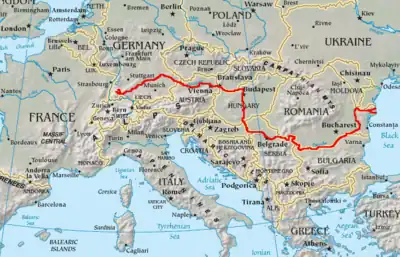Ulm
Ulm (German pronunciation: [ʊlm] ⓘ) is a city in the German state of Baden-Württemberg, situated on the river Danube on the border with Bavaria. The city, which has an estimated population of more than 126,000 (2018), forms an urban district of its own (German: Stadtkreis) and is the administrative seat of the Alb-Donau district.
Ulm | |
|---|---|
 Ulm with the Ulm Minster | |
 Flag  Coat of arms | |
Location of Ulm | |
 Ulm  Ulm | |
| Coordinates: 48°24′N 09°59′E | |
| Country | Germany |
| State | Baden-Württemberg |
| Admin. region | Tübingen |
| District | Urban district |
| First mentioned | 854 AD |
| Subdivisions | 18 Stadtteile |
| Government | |
| • Lord mayor (2015–23) | Gunter Czisch[1] (CDU) |
| Area | |
| • Total | 118.69 km2 (45.83 sq mi) |
| Elevation | 478 m (1,568 ft) |
| Population (2021-12-31)[2] | |
| • Total | 126,949 |
| • Density | 1,100/km2 (2,800/sq mi) |
| Time zone | UTC+01:00 (CET) |
| • Summer (DST) | UTC+02:00 (CEST) |
| Postal codes | 89073–89081 |
| Dialling codes | 0731, 07304, 07305, 07346 |
| Vehicle registration | UL |
| Website | www.ulm.de |
Founded around 850, Ulm is rich in history and traditions as a former free imperial city (German: freie Reichsstadt). The neighbouring town of Neu-Ulm in Bavaria was part of Ulm until 1810.
Today, Ulm is an economic centre due to its varied industries, and it is the seat of the University of Ulm. Internationally, the city is primarily known for having the church with the tallest steeple in the world (161.53 m or 529.95 ft), the Gothic minster (Ulm Minster, German: Ulmer Münster), and as the birthplace of Albert Einstein.
Geography
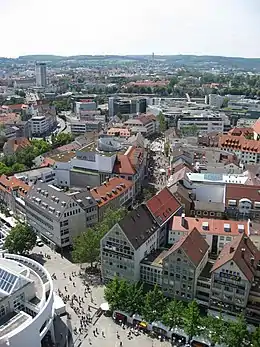
Ulm lies at the point where the rivers Blau and Iller join the Danube, at an altitude of 479 m (1,571.52 ft) above sea level. Most parts of the city, including the old town, are situated on the northern bank of the Danube; only the districts of Wiblingen, Gögglingen, Donaustetten and Unterweiler lie on the southern bank. Across from the old town, on the other side of the river, lies the twin city of Neu-Ulm in the state of Bavaria, smaller than Ulm and, until 1810, a part of it (population c. 50,000).
Except for the Danube in the south, the city is surrounded by forests and hills which rise to altitudes of over 620 metres (2,034.12 feet), some of them part of the Swabian Alb. South of the Danube, plains and hills finally end in the northern edge of the Alps, which are approximately 100 kilometres (62 miles) from Ulm and are visible from the city on clear days.
The city of Ulm is situated in the northern part of the North Alpine Foreland basin, where the basin reaches the Swabian Alb. The Turritellenplatte of Ermingen ("Erminger Turritellenplatte") is a famous palaeontological site of Burdigalian age.
Neighboring communes

On the right (south-eastern) side of Danube and Iller there is the Bavarian district town Neu-Ulm. On the left (north-western) side Ulm is almost completely surrounded by the Alb-Danube district. The neighbouring communes of Baden-Württemberg are the following: Illerkirchberg, Staig, Hüttisheim, Erbach (Donau), Blaubeuren, Blaustein, Dornstadt, Beimerstetten and Langenau as well as the eastern neighbouring community Elchingen.
Town subdivisions
The city is divided into 18 districts (German: Stadtteile): Ulm-Mitte, Böfingen, Donaustetten, Donautal, Eggingen, Einsingen, Ermingen, Eselsberg, Gögglingen, Grimmelfingen, Jungingen, Lehr, Mähringen, Oststadt, Söflingen (with Harthausen), Unterweiler, Weststadt, and Wiblingen.
Nine districts were integrated during the latest municipality reform in the 1970s: Eggingen, Einsingen, Ermingen, Gögglingen-Donaustetten, Jungingen, Lehr, Mähringen und Unterweiler. They have their own local councils which acquire an important consulting position to the whole city council concerning issues that are related to the prevailing districts. But at the end, final decisions can only be made by the city council of the entire city of Ulm.
History

The oldest traceable settlement of the Ulm area began in the early Neolithic period, around 5000 BC. Settlements of this time have been identified at the villages of Eggingen and Lehr, today districts of the city. In the city area of Ulm proper, the oldest find dates from the late Neolithic period. The earliest written mention of Ulm is dated 22 July 854 AD, when King Louis the German signed a document in the King's palace of "Hulma" in the Duchy of Swabia.[3] The city was declared an Imperial City (German: Reichsstadt) by Friedrich Barbarossa in 1181.
At first, Ulm's significance was due to the privilege of a Königspfalz, a place of accommodation for the medieval German kings and emperors on their frequent travels. Later, Ulm became a city of traders and craftsmen. One of the most important legal documents of the city, an agreement between the Ulm patricians and the trade guilds (German: Großer Schwörbrief), dates from 1397. This document, considered an early city constitution, and the beginning of the construction of an enormous church (Ulm Minster, 1377), financed by the inhabitants of Ulm themselves rather than by the church, demonstrate the assertiveness of Ulm's medieval citizens. Ulm blossomed during the 15th and 16th centuries, mostly due to the export of high-quality textiles. The city was situated at the crossroads of important trade routes extending to Italy. These centuries, during which many important buildings were erected, also represented the zenith of art in Ulm, especially for painters and sculptors like Hans Multscher and Jörg Syrlin the Elder. During the Reformation, Ulm became Protestant (1530). With the establishment of new trade routes following the discovery of the New World (16th century) and the outbreak and consequences of the Thirty Years' War (1618–1648), the city began to decline gradually. During the War of the Spanish Succession (1701–1714), it was alternately invaded several times by French and Bavarian soldiers.

In the wars following the French Revolution, the city was alternately occupied by French and Austrian forces, with the former ones destroying the city fortifications. In 1803, it lost the status of Imperial City and was absorbed into Bavaria. During the campaign of 1805, Napoleon managed to trap the invading Austrian army of General Mack and forced it to surrender in the Battle of Ulm. In 1810, Ulm was incorporated into the Kingdom of Württemberg and lost its districts on the other bank of the Danube, which came to be known as Neu-Ulm (New Ulm).
In the mid-19th century, the city was designated a fortress of the German Confederation with huge military construction works directed primarily against the threat of a French invasion. The city became an important centre of industrialisation in southern Germany in the second half of the 19th century, its built-up area now being extended beyond the medieval walls. The construction of the huge minster, which had been interrupted in the 16th century for economic reasons, was resumed and eventually finished (1844–1891) in a wave of German national enthusiasm for the Middle Ages.
From 1933 to 1935, a concentration camp primarily for political opponents of the regime was established on the Kuhberg, one of the hills surrounding Ulm. The Jews of Ulm, around 500 people, were first discriminated against and later persecuted; their synagogue was torn down during Kristallnacht in November 1938. Of 116 Jews deported from Ulm during World War II (45 were sent to Theresienstadt on 22 August 1942), only four returned.[4] Approximately 25 Jews were living in Ulm in 1968.
The sole RAF strategic bombing during World War II against Ulm occurred on 17 December 1944, against the two large lorry factories of Magirus-Deutz and Kässbohrer, as well as other industries, barracks, and depots in Ulm. The Gallwitz Barracks and several military hospitals were among 14 Wehrmacht establishments destroyed.[5] The raid killed 707 Ulm inhabitants and left 25,000 homeless and after all the bombings, over 80% of the medieval city centre lay in ruins.
Some parts of the city were rebuilt in the plain and simple style of the 1950s and 1960s, but most parts of the historic old town have been restored.[6] Due to its almost complete destruction in 1944, the Hirschstraße part of the city primarily consists of modern architecture. Ulm experienced substantial growth in the decades following World War II, with the establishment of large new housing projects and new industrial zones. In 1967, Ulm University was founded, which proved to be of great importance for the development of the city. Particularly since the 1980s, the transition from classical industry towards the high-tech sector has accelerated, with, for example, the establishment of research centres of companies like Daimler, Siemens and Nokia and a number of small applied research institutes near the university campus. The city today is still growing, forming a twin city of 170,000 inhabitants together with its neighbouring Bavarian city of Neu-Ulm, and seems to benefit from its central position between the cities of Stuttgart and Munich and thus between the cultural and economic hubs of southern Germany.
| Nationality | Population (2018) |
|---|---|
| 4,782 | |
| 2,009 | |
| 1,557 | |
| 1,532 | |
| 1,319 | |
| 959 | |
| 823 | |
| 783 | |
| 740 | |
| 678 | |
| 626 |
Demographics
| Year | Pop. | ±% |
|---|---|---|
| 1300 | 4,000 | — |
| 1400 | 9,000 | +125.0% |
| 1550 | 19,000 | +111.1% |
| 1750 | 15,000 | −21.1% |
| 1818 | 13,000 | −13.3% |
| 1871 | 26,290 | +102.2% |
| 1900 | 42,982 | +63.5% |
| 1910 | 56,109 | +30.5% |
| 1919 | 56,020 | −0.2% |
| 1925 | 57,278 | +2.2% |
| 1933 | 62,472 | +9.1% |
| 1939 | 75,503 | +20.9% |
| 1946 | 58,087 | −23.1% |
| 1950 | 71,132 | +22.5% |
| 1956 | 90,530 | +27.3% |
| 1961 | 92,705 | +2.4% |
| 1970 | 92,943 | +0.3% |
| 1987 | 103,494 | +11.4% |
| 2011 | 117,541 | +13.6% |
| 2017 | 125,596 | +6.9% |
| 2018 | 125,805 | +0.2% |
| 2019 | 126,329 | +0.4% |
| Population size may be affected by changes in administrative divisions. source:[7] | ||
Climate
| Climate data for Ulm (1991–2020 normals) | |||||||||||||
|---|---|---|---|---|---|---|---|---|---|---|---|---|---|
| Month | Jan | Feb | Mar | Apr | May | Jun | Jul | Aug | Sep | Oct | Nov | Dec | Year |
| Average high °C (°F) | 1.9 (35.4) |
3.8 (38.8) |
8.9 (48.0) |
13.7 (56.7) |
18.2 (64.8) |
21.4 (70.5) |
23.3 (73.9) |
23.2 (73.8) |
18.2 (64.8) |
12.5 (54.5) |
6.1 (43.0) |
2.3 (36.1) |
12.7 (54.9) |
| Daily mean °C (°F) | −0.6 (30.9) |
0.3 (32.5) |
4.5 (40.1) |
8.8 (47.8) |
13.2 (55.8) |
16.4 (61.5) |
18.2 (64.8) |
17.9 (64.2) |
13.5 (56.3) |
8.6 (47.5) |
3.4 (38.1) |
0.0 (32.0) |
8.6 (47.5) |
| Average low °C (°F) | −3.0 (26.6) |
−2.8 (27.0) |
0.6 (33.1) |
4.1 (39.4) |
8.2 (46.8) |
11.4 (52.5) |
13.2 (55.8) |
12.9 (55.2) |
9.2 (48.6) |
5.3 (41.5) |
1.0 (33.8) |
−2.2 (28.0) |
4.8 (40.6) |
| Average precipitation mm (inches) | 42.9 (1.69) |
35.3 (1.39) |
47.5 (1.87) |
45.5 (1.79) |
81.2 (3.20) |
82.7 (3.26) |
88.6 (3.49) |
85.1 (3.35) |
58.2 (2.29) |
57.5 (2.26) |
50.9 (2.00) |
57.6 (2.27) |
731.5 (28.80) |
| Average precipitation days (≥ 1.0 mm) | 15.3 | 14.1 | 15.0 | 13.8 | 15.8 | 15.4 | 15.8 | 14.4 | 13.7 | 16.2 | 15.8 | 17.9 | 182.9 |
| Average relative humidity (%) | 89.7 | 84.4 | 76.3 | 70.0 | 71.3 | 71.8 | 71.9 | 72.9 | 79.5 | 87.1 | 91.0 | 91.2 | 79.8 |
| Mean monthly sunshine hours | 54.7 | 84.0 | 134.5 | 175.9 | 209.1 | 221.1 | 233.9 | 218.6 | 151.2 | 94.1 | 47.4 | 43.5 | 1,652.8 |
| Source: World Meteorological Organization[8] | |||||||||||||
Economy
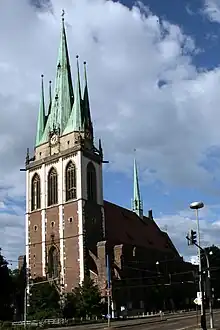
The city has very old trading traditions dating from medieval times and a long history of industrialisation, beginning with the establishment of a railway station in 1850. The most important sector is still classical industry (machinery, especially motor vehicles; electronics; pharmaceuticals). The establishment of the University of Ulm in 1967, which focuses on biomedicine, the sciences, and engineering, helped support a transition to high-tech industry, especially after the crisis of classical industries in the 1980s.
Companies with headquarters in Ulm include:
- Britax (child safety products) European headquarters in nearby Leipheim
- Ebner & Spiegel (book printing)
- Gardena (gardening tools)
- Krieghoff (weapons for hunting and sports since 1886)
- Iveco Magirus
- J. G. Anschütz (firearms for sports and hunting)
- Liqui Moly (additives, oils, car care products)
- Müller (major German trade company)
- Ratiopharm (pharmaceuticals)
- Seeberger (dried fruits, coffee, tea)
- Uzin Utz (construction materials)
- Walther Arms (fire arms, especially pistols)
- Wieland Group (non-ferrous semi-finished products)
- Zwick Roell Group www.zwick.de (Materials Testing Machines)
Companies with important sites in Ulm include:
- AEG
- Atmel
- BMW Car IT[9]
- Continental
- Daimler: Daimler Forschungszentrum (research centre) and Daimler TSS (car IT specialist)
- Deutsche Telekom
- Elektrobit Automotive
- EADS, European Aeronautic Defence and Space Company
- Nokia Networks[10]
- Nuance Communications Speech Recognition (research departments)
- Siemens
- Harman International Industries
Ecology
In 2007 the City of Ulm was awarded the European Energy Award for its remarkable local energy management and its efforts to combat climate change.[11] Examples of these efforts are a biomass power plant operated by the Fernwärme Ulm GmbH (10 MW electrical output), and the world's biggest passive house office building, the so-called Energon, located in the "Science City" near the university campus. Moreover, the city of Ulm boasts the second largest solar power production in Germany.[12] For all new buildings, a strict energy standard (German KFW40 standard) has been mandatory since April 2008. Ulm Minster has been fully powered by renewables since January 2008.[13] Until the end of 2011 as a European pilot project a self-sustaining data-centre will be constructed in the west-city of Ulm.[14] There is a solar-powered ferry that crosses the Danube 7 days a week in summer.[15] The "Bündnis 100% Erneuerbare Energien" was founded in February 2010 with the aim of bringing together the people and organisations seeking to promote the transition to 100% renewable energy in Ulm and Neu-Ulm by 2030.[16]
Transportation

Ulm is situated at the crossroads of the A8 motorway (connecting the principal cities of southern Germany, Stuttgart and Munich), and the A7 motorway (one of the motorways running from northern to southern Europe).
The city's railway station is served, among other lines, by one of the European train routes (Paris – Strasbourg – Stuttgart – Ulm – Munich – Vienna – Budapest). Direct connections to Berlin are also available.
Ulm's public transport system is based on several bus lines and two tram lines. Several streets in the old town are for the use of pedestrians and cyclists only. Ulm was the first area to be served by the Daimler AG's Car2Go carsharing service in 2008. However, the service in Ulm was discontinued at the end of 2014.
Education and culture

The University of Ulm was founded in 1967 and focuses on the sciences, medicine, engineering, and mathematics / economics. With about 10,000 students, it is one of the smaller universities in Germany.[17]
Ulm is also the seat of the city's University of Applied Sciences (German: Fachhochschule), founded in 1960 as a public school of engineering. The school also houses numerous students from around the world as part of an international study abroad programme.
In 1953, Inge Aicher-Scholl, Otl Aicher and Max Bill founded the Ulm School of Design (German: Hochschule für Gestaltung – HfG Ulm), a design school in the tradition of the Bauhaus, which was, however, closed in 1968.[18]
Ulm's public library features over 480,000 print media. The city has a public theatre with drama, opera and ballet,[19] several small theatres,[20] and a professional philharmonic orchestra.[21]
Sport

- SSV Ulm 1846, multi-sports club, former football Bundesliga club, now Regionalliga Süd
- Ratiopharm Ulm, basketball club, Basketball Bundesliga
| Club | Founded | League | Sport | Venue | Capacity |
|---|---|---|---|---|---|
| SSV Ulm 1846 | 1846 | Football | Donaustadion | 19,500 | |
| Ratiopharm Ulm | 2001 | Basketball Bundesliga | Basketball | Ratiopharm arena | 6,000 |
Sights

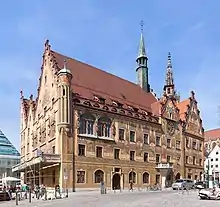
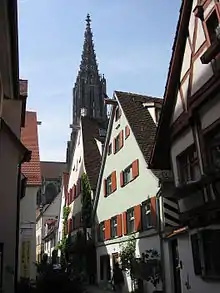
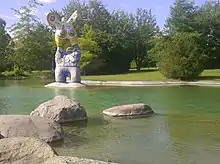
Historic
- Ulm Minster (German: Ulmer Münster, built 1377–1891) with the world's highest church steeple (161.53 m (529.95 ft) high and 768 steps). Choir stalls by Jörg Syrlin the Elder (1469–1474), famous sculpture Schmerzensmann (Man of Sorrows) by Hans Multscher (1429).
- The old Fischerviertel (fishermen's quarter) on the River Blau, with half-timbered houses, cobblestone streets, and picturesque footbridges. Interesting sights here are the Schiefes Haus Ulm (crooked house), a 16th-century house today used as a hotel, and the Alte Münz (Old Mint), a mediaeval building extended in the 16th and 17th centuries in Renaissance style.
- The remaining section of the city walls, along the river, with the 14th-century Metzgerturm (butchers' tower) (36 m (118.11 ft) high).
- The Rathaus (Town Hall), built in 1370, featuring some brilliantly coloured murals dating from the mid-16th century. On the gable is an astronomical clock dating from 1520. Restored after serious damage in 1944.
- The Krone inn, a medieval complex of several houses (15th / 16th century, extensions from the 19th century), where German kings and emperors were accommodated during their travels.
- Several large buildings from the late Middle Ages / renaissance used for various purposes (especially storage of food and weapons), e.g. Schwörhaus, Kornhaus, Salzstadel, Büchsenstadel, Zeughaus, Neuer Bau.
- Ulm Federal Fortifications are the largest preserved fortifications and were built from 1842 to 1859 to protect from attacks by France.
- The historic district Auf dem Kreuz, a residential area with many buildings from before 1700.
- Wiblingen Abbey, a former Benedictine abbey in the suburb of Wiblingen in the south of Ulm. The church shows characteristics of late baroque and early classicism. Its library is a masterpiece of rococo.[22]
Contemporary
- Building of the Ulm School of Design (German: Hochschule für Gestaltung – HfG Ulm), an important school of design (1953–1968) in the succession of the Bauhaus.
- Stadthaus, a house for public events built by Richard Meier, directly adjacent to the minster.
- Stadtbibliothek, the building of the public library of Ulm was erected by Gottfried Böhm in the form of a glass pyramid and is situated directly adjacent to the town hall.
- Kunsthalle Weishaupt is the highlight in Ulm's New Centre.
Museums
- The Kunsthalle Weishaupt.[23] The private Collection shows modern art from 1945.
- Ulm Museum[24] houses a significant collection of art and craftwork from the Middle Ages, the Löwenmensch figurine – a 40,000-year-old lion-headed figurine which is the oldest known human/animal shaped sculpture in the world – and various European and American art from the years after 1945. The museum has alternating exhibitions.
- The Museum of Bread Culture[25] offers a permanent exhibition about the history of grain, baking, milling and bread culture.
- The exhibitions in the Danube Swabian Museum[26] follow the varied history of the Danube Swabians (Donauschwaben) emigrants.
Memorials
- Albert Einstein Memorial – A small memorial at the site of the house where Albert Einstein was born in Bahnhofstraße, between the present-day newspaper offices and the bank. The house itself and the whole district were destroyed in the firebombing of 1944.
- Memorial to Hans and Sophie Scholl – A small memorial on the Münsterplatz in memory of these two members of the Weiße Rose (White Rose, a resistance group opposed to the Nazi regime), who spent their youth in Ulm. Their family's house near the memorial was destroyed in the firebombing of 1944.
- The Memorial to Deserters – Located near the university's botanical garden, it commemorates those who deserted from the Wehrmacht during World War II. It was originally erected on 9 September 1989, and was moved to its current location in July 2005. The Monument represents the idea: "Desertion is not reprehensible, war is".
Other landmarks
- The Botanischer Garten der Universität Ulm, the university's botanical garden
- Silo tower of the mill company Schapfenmühle (Schapfen Mill Tower)
- Sender Ulm-Ermingen, television and radio tower
- Medium wave transmission mast Ulm-Jungingen
- FM and TV mast Ulm-Kuhberg
- The Tiergarten Ulm, the zoo. It was opened in 1935, closed in 1944 and reopened in 1966.
Notable people
Born in Ulm
- Otl Aicher (1922–1991), graphic designer, co-founder of Ulm School of Design, (German: Hochschule für Gestaltung – HfG Ulm), and creator of Rotis font
- Ernst Bauer (1917–1991), resistance fighter and publisher
- Max Bentele (1909–2006), mechanical engineer, jet-engine pioneer, father of the Wankel rotary engine
- Albrecht Berblinger (1770–1829), flight pioneer
- Dieter Braun (b. 1943), Motorcycle Grand Prix racer
- Hermann Duckek (1936–2001), riding master and Olympic equestrian arena designer

- Albert Einstein (1879–1955), physicist, philosopher, scientist, Nobel Prize-winner
- Jerome Emser (1477–1527), a German theologian and antagonist of Luther.[27]
- Helmut Ensslin (1909–1984), Protestant parson and father of RAF-member Gudrun Ensslin
- Anna Essinger (1879–1960) educator; co-founder and headmistress of Bunce Court School
- Johann Faulhaber (1580–1635), mathematician, inventor of Faulhaber's formula.
- Nikolaus Federmann (1505–1542), adventurer and conquistador in modern-day Venezuela and Colombia, co-founder of Santafé de Bogotá
- Johann Freinsheim (1608–1660), a German classical scholar and critic.[28]
- Eugen Haile (1873–1933), composer, singer and accompanist
- Fritz Hartnagel (1917–2001), officer and jurist, fiancé of Sophie Scholl
- Hellmut Hattler (b. 1952) jazz and rock bass player (Kraan)
- Max Hattler (b. 1976) artist and film-maker
- Johann Christoph Heilbronner (1706–c.1747) mathematical historian
- Leo Hepp (1907–1987), officer of the Wehrmacht and General of the Bundeswehr
- Dieter Hoeneß (b. 1953), former football player, former general manager of Hertha BSC and VfL Wolfsburg football club
- Uli Hoeneß (b. 1952), former football player, president of Bayern Munich football club
- Annemarie Huste (1943–2016), chef to Jackie Kennedy, executive chef Gourmet Magazine, author of 6 cookbooks
- Otto Kässbohrer (1904–1989), entrepreneur and constructor
- Karl Kimmich (1880–1945), banker
- Hildegard Knef (1925–2002), actress, singer and writer
- Mike Krüger (b. 1951) comedian, actor and singer
- Hellmuth Laegeler (1902–1972), major general in the Wehrmacht
- Hans Maler zu Schwaz (1480/1488 – 1526/1529) painter, active as portraitist at Schwaz near Innsbruck.
- Erwin Piscator (1893–1966), theatre director and innovator
- Sam Rosen (b. 1947) an American sportscaster (MSG Network)
- Claudia Roth (b. 1955), politician, chairman of the German Green Party
- Wilhelm Schuler (1914–2010), chemist, inventor and entrepreneur in the second half of the 20th century.
- Katharina Sophia Volz (1987), a medical researcher and entrepreneur.
Otherwise associated with Ulm
- Max Bill (1908–1994), architect and artist, co-founder and director of the Ulm School of Design (German: Hochschule für Gestaltung – HfG Ulm)
- Robert Bosch (1861 in Albeck – 1942), industrialist, engineer and inventor, founder of Robert Bosch GmbH.
- Matthäus Böblinger (1450-1505), stonemason and master builder, helped construct Ulm Minster
- Rene Descartes (1596–1650), philosopher, experienced a powerful vision near Ulm in 1619.[29][30]
- Ulrich Ensingen (1350/60 – 1419), master builder, helped construct Ulm Minster and Strasbourg Cathedral
- Leonhard Hutter (1563 in Nellingen – 1616) a German Lutheran theologian.[31]
- Herbert von Karajan, (1908–1989), conductor, Kapellmeister in Ulm, 1929–1934.
- Johannes Kepler (1571–1630), a German mathematician, astronomer and astrologer; lived in Ulm
- Gerhard Klopfer (1905–1987), senior official of the Nazi Party, SS General. Present at the Wannsee Conference; tax advisor and lawyer in Ulm postwar
- Hans Multscher (ca.1400 – 1467 in Ulm), a German sculptor and painter.
- Erwin Rommel (1891 in Heidenheim – 1944 at Herrlingen) a German field marshal in WWII.
- Hans Scholl (1918–1943) & Sophie Scholl (1921–1943), founded the White Rose, spent their youth in Ulm
- Carl Teike (1864–1922), composed the military march Alte Kameraden in Ulm in 1889
International relations
Ulm is a member city of the Eurotowns network.[32]
Ulm is officially not twinned. But there are relations with:
 Arad, Romania
Arad, Romania Baja, Hungary
Baja, Hungary Bratislava, Slovakia [33]
Bratislava, Slovakia [33] Budapest, Hungary
Budapest, Hungary Cluj-Napoca, Romania
Cluj-Napoca, Romania Jinotega, Nicaragua
Jinotega, Nicaragua Kladovo, Serbia
Kladovo, Serbia New Ulm, Minnesota, United States [34]
New Ulm, Minnesota, United States [34] Novi Sad, Serbia
Novi Sad, Serbia Sibiu, Romania
Sibiu, Romania Silistra, Bulgaria
Silistra, Bulgaria Subotica, Serbia
Subotica, Serbia Timișoara in Romania
Timișoara in Romania Tulcea, Romania
Tulcea, Romania Vidin, Bulgaria
Vidin, Bulgaria Vukovar, Croatia [34]
Vukovar, Croatia [34]
References
Notes
- Oberbürgermeisterwahl Ulm 2015, Staatsanzeiger.
- "Bevölkerung nach Nationalität und Geschlecht am 31. Dezember 2021" [Population by nationality and sex as of December 31, 2021] (CSV) (in German). Statistisches Landesamt Baden-Württemberg. June 2022.
- "ulm-by-michael-vogt". 500px.com. Retrieved 24 May 2014.
- "Ulm". jewishvirtuallibrary.org. Retrieved 14 January 2020.
- "RAF History – Bomber Command 60th Anniversary". Raf.mod.uk. Archived from the original on 6 July 2007. Retrieved 6 May 2009.
- https://www.ulm.uno/index.php/ulm-city/altstadt-nord-ulm
- Link
- "World Meteorological Organization Climate Normals for 1991–2020". World Meteorological Organization Climatological Standard Normals (1991–2020). National Oceanic and Atmospheric Administration. Archived from the original on 12 October 2023. Retrieved 13 October 2023.
- "Homepage – BMW Car IT".
- "Homepage – Nokia Networks in Germany".
- Stadt Ulm. "Stadt Ulm – Ulm erhält 'European Energy Award'". Archived from the original on 4 July 2018. Retrieved 12 December 2018.
- Lars Schulz (27 March 2010). "Solarbundesliga". Solarbundesliga.de. Retrieved 8 April 2010.
- SWU Fakten, Stadtwerke Ulm, visited 15. Mai 2008.
- "Press release at Gruene-IT.de".
- "Solarstiftung Ulm/Neu-Ulm – Home". Solarboot-ulm.de. Archived from the original on 6 January 2014. Retrieved 12 March 2013.
- Roland Fuchs. "Home – Bündnis 100% Erneuerbare Energien". 100ee.de. Retrieved 20 March 2010.
- "The University of Ulm". Retrieved 9 March 2011.
- "HfGArchiv Ulm – History". HfG-Archiv Ulm. 2003. Archived from the original on 19 July 2011. Retrieved 9 March 2011.
- "Theatre Ulm". Retrieved 9 March 2011.
- "Theatres & Stages". Retrieved 9 March 2011.
- "Theater Ulm – Konzerte" (in German). Archived from the original on 26 January 2011. Retrieved 9 March 2011.
- "Page with photos of Wiblingen Abbey's Baroque library". Archived from the original on 17 July 2011. Retrieved 16 January 2019.
- "kunsthalle weishaupt – Moderne und zeitgenössische Kunst in Ulm". kunsthalle weishaupt.
- http://www.tourismus.ulm.de/tourismus/en/sehenswert/museen_und_co/ulmer_museum/ulmer_museum.php
- "Museum der Brotkultur in Ulm - - english content". Archived from the original on 31 October 2013. Retrieved 18 March 2013.
- "Donauschwäbisches Zentralmuseum Ulm – ENG". www.dzm-museum.de. Archived from the original on 17 October 2003. Retrieved 6 June 2022.
- Pollard, Albert Frederick (1911). . Encyclopædia Britannica. Vol. 9 (11th ed.). p. 362.
- . Encyclopædia Britannica. Vol. 11 (11th ed.). 1911. p. 95.
- Wallace, William (1911). . Encyclopædia Britannica. Vol. 8 (11th ed.). pp. 79–90.
- Terence McKenna ~ Science Was Founded by an Angel. 2 January 2010. Archived from the original on 7 November 2021 – via YouTube.
- . Encyclopædia Britannica. Vol. 14 (11th ed.). 1911. p. 15.
- "Eurotowns – The future's city network in Europe (2019)". Eurotowns.
- "Partner (Twin) towns of Bratislava". Bratislava-City.sk. Archived from the original on 28 July 2013. Retrieved 5 August 2013.
- "Ulm – International Contacts (in German)". City of Ulm. Archived from the original on 19 July 2011. Retrieved 22 February 2011.
Bibliography
- Johannes Baier: Über die Tertiärbildungen im Ulmer Raum. In: Documenta Naturae. 168; München, 2008. ISBN 978-3-86544-168-3.
External links
- Official website of the city
- Official Tourism Website of Ulm and Neu-Ulm
- Official website of the University of Ulm
- Ulm public library Archived 21 February 2015 at the Wayback Machine (in German)

